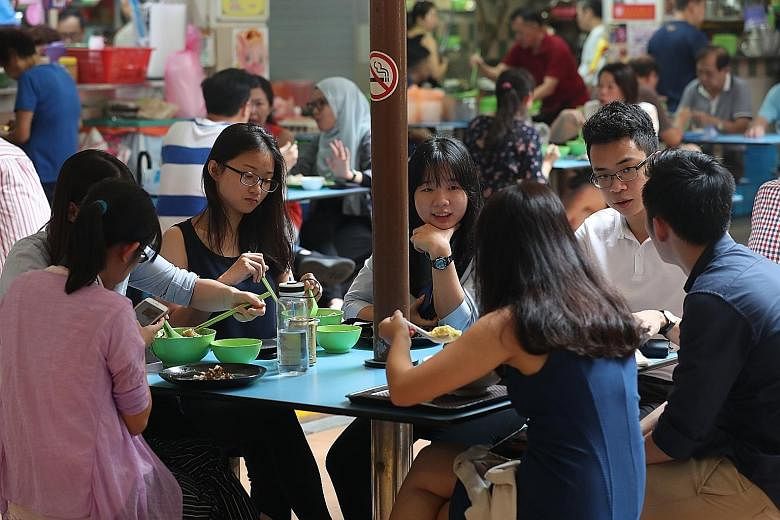The Republic's nomination to inscribe hawker culture in Singapore on the Unesco Representative List of the Intangible Cultural Heritage of Humanity was submitted on Wednesday.
The nomination includes letters, photographs and videos demonstrating community support for the bid, the organisations behind the attempt said in a joint statement yesterday.
The photographs feature an Indian Muslim hawker preparing briyani, a Chinese hawker demonstrating a chicken rice recipe, and a father and his children enjoying the chendol dessert, among other snapshots.
A 10-minute video was also produced to give a 12-member Unesco evaluation body - including six experts qualified in various fields of intangible cultural heritage - a better understanding of hawker culture in Singapore.
The nomination documents, to be available for public viewing from July, were submitted jointly by the three organisations driving the bid. They are the National Heritage Board, the National Environment Agency and The Federation of Merchants' Associations, Singapore (FMAS).
Using the evaluation body's assessment and recommendation as a guide, a 24-member intergovernmental committee will then decide on the suitability of inscribing Singapore's hawker culture.
The results will be announced at the end of next year.
Mr Low Hock Kee, 50, a second-generation hawker and co-chairman of the hawker sub-committee of FMAS, believes that if the inscription is successful, the profile of the country's rich cultural heritage will be boosted. "The nomination also helps elevate the status of hawkers and affirms our role in Singapore."
If successful, hawker culture will join 429 cultures of other countries which have been inscribed since the list was established in 2008. These include Belgium's beer culture, Indonesia's bamboo musical instrument angklung, China's shadow puppetry, and kimjang, or the making and sharing of kimchi in South Korea.
Unlike the evaluation of world heritage sites, assessments of intangible cultural heritage do not require evaluators to make site visits.
Countries whose bids are not successful can reapply in subsequent Unesco evaluation cycles.
Singapore's first such submission in the category of intangible cultural heritage comes after the Botanic Gardens was made a Unesco World Heritage Site in 2015.
Singapore's hawker culture bid has drawn some criticism from across the border. Some Malaysians have claimed their country is a street-food paradise, and that Singapore's hawker version is not that special.
However, the list is not intended to define the origins and ownership of cultural practices. For instance, both Arabic coffee and Turkish coffee were inscribed in the Unesco list.
Instead, Singapore's attempt will be assessed based on the criteria of meeting Unesco's definition of intangible cultural heritage; how the potential inscription will increase awareness of Singapore's intangible cultural heritage; how the existing and future safeguarding measures promote the continued practice of the culture; whether the nomination involved the community; and whether it is part of the country's intangible cultural heritage inventory.
The country's inventory, comprising 70 elements so far, includes pilgrimages to Kusu Island and Malay weddings, and was established last April.
In a joint statement, the organisations driving the bid said the attempt has received overwhelming support from Singaporeans since it was announced last August.
They noted that apart from hawker associations, more than 850,000 pledges of support and over 31,000 messages were registered across various platforms.
Their social media movement, they added, generated 810,000 likes and comments in support of hawker culture.
The statement said: "A successful nomination will demonstrate to the world how proud we are of hawker culture in Singapore, encourage greater appreciation for our hawkers, and show our commitment as a nation to safeguard hawker culture for generations to come."
They added that the submission of the nomination documents is a milestone in Singapore's Unesco inscription journey to better recognise and protect the island's intangible cultural heritage.
The nomination documents took into account input from a nomination committee, comprising representatives and stakeholders from various sectors, including hawker representatives, academics, community partners, non-governmental organisations and government agencies.
Key characteristics of Singapore's hawker culture include hawker centres serving as community dining spaces for all, and how it is a reflection of Singapore's multicultural society. Other features are Singapore hawkers' mastery of culinary skills and how hawker culture thrives in a highly urban environment.
There are more than 100 hawker centres in Singapore and some 6,000 hawkers who each serve about 150 to 200 affordable meals daily. More than 80 per cent of the population visit hawker centres at least once a week.
Messages written by Singaporeans in support of the bid note that hawker centres serve as spaces where "a variety of multicultural cuisines" can be found under one roof, and where "people of all races gather to eat together".


